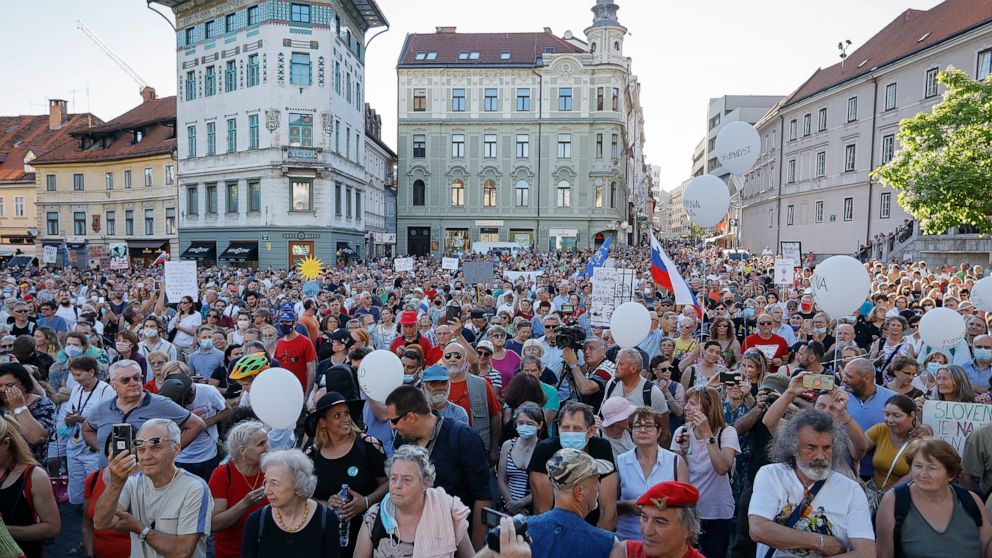Slovenia’s term raises specter of EU’s threat from within
KRANJ, Slovenia — Tiny Slovenia took charge of the world’s largest trading bloc this week, and immediately shone a harsh spotlight on one of the European Union’s most vexing problems: How to accommodate increasingly vocal member countries with very different visions of Europe’s future.
Already, nationalist governments in Hungary and Poland are worrying their more politically mainstream partners in the 27-nation EU. Some fear that new legislation introduced by the two countries could undermine democratic standards and the independence of the judiciary.
Then on Thursday, Slovenia’s return to the European stage — it took over the EU’s rotating presidency for six months — was marked by concerns about the right-wing government’s record on media freedoms and its failure to nominate legal experts to the fraud-busting European Public Prosecutor’s Office.
For Prime Minister Janez Jansa — who leads the Alpine nation of just 2 million people nestled between Austria, Croatia, Hungary and Italy — Slovenia is a misunderstood victim of “double standards,” sometimes at the hands of the EU’s increasingly powerful executive branch, the European Commission.
“We are not a colony. We are not a second-class member of the European Union,” Jansa told foreign reporters on Friday. His remarks highlighted the growing tensions between newer EU members from central and eastern Europe and the founding states from the continent’s west.
“The EU brings together countries with different traditions, with different cultures. There are differences that need to be taken into account and respected,” he said, during an exchange that lasted well over an hour.
Pressure mounted on Jansa’s government recently as it prepared for its EU presidency, which is largely about acting as an “honest broker” to find consensus among the 27 nations and ensure the smooth adoption of policies ranging from the environment to migration.
Protests in the capital, Ljubljana, have become routine. In late May, around 20,000 people gathered in a central square to demand that the government step down.
Jansa is accused of becoming increasingly authoritarian in ways similar to those of his ally, hardline Hungarian Prime Minister Viktor Orban. Critics say Jansa’s government has pressured Slovenian media, spurred hate speech and mismanaged the coronavirus pandemic.
Asked about his attitude toward “illiberal democracies” like those in Hungary and Poland, the 62-year-old former journalist replied: “For me, all of these mainstream political orientations are equal, and equally legitimate.”
“I cannot agree to the division between liberal and illiberal democracy. Democracy is democracy,” Jansa said, before going on to give a favorable account of Orban and what he has done for Hungary. “If I fight for the affection of my voters, in a free world, everyone is equal.”
The Slovenian premier has come under particular scrutiny for keeping a stranglehold on funds for Slovenia’s only news agency, the STA. He says he expects the issue to be resolved this fall, but exactly how is unclear.
On Friday, he showed reporters a video that he said depicted the media pressure applied by more left-leaning politicians. It listed a number of journalists, including well-known TV news personalities, who have switched to jobs in government or parliament.
“You are accusing this government that we are suppressing media freedom,” Jansa said in English. “When we defend ourselves, and we are under attack all the time, this is not suppressing media freedom.”
“It’s not good if you’re criticized in whatever you’re doing. If you’re making restrictions regarding COVID, you’re criticized. If not making the restrictions, you’re criticized. At the end, people are dying because of the pandemic. It’s not so simple,” he said.
Jansa’s use of images to make a point didn’t go down well with the commission at Thursday’s meeting to mark the start of Slovenia’s presidency. During a complaint about “leftist” politicians, he displayed a photograph of two Slovenian judges alongside opposition members.
That prompted a walkout by European Commission Executive Vice-President Frans Timmermans. He refused to take part in the “family photo” between Slovenia’s Cabinet and the commissioners.
“I simply could not be on the same podium with PM Jansa after his unacceptable attack,” Timmermans said later.
The following day, Interior Minister Ales Hojs, talking about anti-government protesters, said: “I personally do not want to call anyone a swine. But perhaps once in the future, after everything I heard yesterday, I will be able to call a certain individual a swine.”
“They were not on the square (among the protesters), but they sit high in the European bureaucracy,” Hojs told reporters. He later denied via Twitter that he was referring to Timmermans.
Ultimately, the tensions suit both parties. Small Slovenia appears to be punching above its political weight, while the EU’s executive branch comes across as a righteous defender of Europe’s values.
More problematic though is that the dispute was over the independence of judges, and came amid concern that Slovenia has delayed its appointment of legal experts to Europe’s public prosecutors office, which investigates the misuse of EU funds.
It came on the day that the commission endorsed Slovenia’s post-pandemic plan to revive its economy with 2.5 billion euros ($3 billion) in grants and loans of European money. Hungary’s national plan still hasn’t been approved amid concerns over democratic backsliding there.
In March, Hungary’s ruling party pulled out of the biggest mainstream political group in the European Parliament in acrimony. The Fidesz party’s membership had already been suspended by the group, the European People’s Party.
Jansa suggested that his party too might be ready to walk away.
“I think there will be some changes in the future, we hope so, toward the original idea of the European People’s Party,” he said. “If this is not the case, there are other options.”
![]()


